AUCTORES
Globalize your Research
Research Article | DOI: https://doi.org/10.31579/2768-0487/165
1 Demonstrator of Maternal & Newborn Health Nursing, Faculty of Nursing, Beni-Suef University, Egypt.
2 Lecturer of Maternal & Newborn Health Nursing, Faculty of Nursing, Beni-Suef University, Egypt.
3 Professor of Maternal and Newborn Health Nursing, Faculty of Nursing, Beni-Suef University, Egypt.
*Corresponding Author: Hanan Elzeblawy Hassan., Demonstrator of Maternal & Newborn Health Nursing, Faculty of Nursing, Beni-Suef University, Egypt.
Citation: Sahar G Zaki., Fatma S Nady., Hanan E Hassan., (2025). Female Workers’ Total Practices Regarding Breast Self-Examination at Beni-Suef University., Journal of Clinical and Laboratory Research 8(2); DOI:10.31579/2768-0487/165
Copyright: © 2025, Hanan Elzeblawy Hassan. This is an open-access article distributed under the terms of the Creative Commons Attribution License, which permits unrestricted use, distribution, and reproduction in any medium, provided the original author and source are credited.
Received: 20 January 2025 | Accepted: 10 February 2025 | Published: 17 February 2025
Keywords: practices; breast self-examination; female workers
Background: Women who self-examine their breasts get familiar with their appearance and feel, and they can identify any changes in their breasts as soon as feasible.
Aim: assess female workers’ total practices regarding breast self-examination at Beni-Suef University. Subjects and Methods: A descriptive sample of 323 working women at Beni-Suef University was selected.
Tools: (I): A Structured Interviewing Questionnaire Sheet. (II): Breast Self-Examination Checklist.
Results: It revealed that 53.8% of the studied sample were married at ages 17-22 years, 82.8 had practiced breastfeeding, 65.4% stopped menstruation at age >45 years, 71.8% had used contraception, 73.1% didn’t have family history of breast cancer, 93.5% didn’t performed mammogram. Related to BSE, 50.5% knew that breast self-examination was the first method in the early diagnosis of breast cancer, 74.9% did not practice breast self-examination, 48.3% not knowing how it was practiced. Also, 90.1% of the female workers having inadequate total practices level regarding breast self-examination, 44.9% get information from social media.
Conclusion: Based on the findings of the present study, it can be concluded that there were statistically significant relation between the studied female workers total practices level regarding breast self-examination score with their educational level and place of residence, family history of breast cancer. A highly statistically significant relation with their total practice level of breast self-examination and source of information was observed. Recommendations: Implement an educational program to enhance women’s practices regarding breast self-examination.
Physical breast examination, breast self-examination, and a clinical breast examination are all included in the physical breast examination. Breast self-examination involves utilizing a mirror and one's hands to check for changes in one's breasts and underarms. In contrast, a doctor performing a clinical breast examination looks for lumps and other abnormalities that could indicate breast cancer. Clinicians perform physical examinations, which involve examining the breasts, the region surrounding the neck and collarbone, and the armpits (axillae). Breast abnormalities, such as lumps or other signs of breast cancer, are observed. Lymph nodes are also examined as they are typically enlarged in breast cancer patients [1-4].
Women who self-examine their breasts get familiar with their appearance and feel, and they can identify any changes in their breasts as soon as feasible. Since many breast cancers are discovered by women themselves, breast self-examination is best done after menstruation (days 5 to 7, if one counts the first day of menses as day 1). Teaching all women how and when to inspect their breasts is a top goal. Women who self-examine their breasts significantly contribute to the early detection of breast cancer and the decrease in cancer-related deaths [5-8].
It has been discovered that nurses use three different methods to look for lumps during a breast self-examination: Tissue sections can be examined in three different ways: 1) the concentric circle method, which looks in increasing or decreasing concentric spheres; 2) the radial spoke, which looks at the edges and moves in a circular pattern toward the nipple; and 3) the vertical strip approach, which examines the breast in perpendicular pieces that intersect and move throughout the chest [9-11].
Aim Of the Study
The current study was conducted to assess female workers’ total practices regarding breast self-examination at Beni-Suef University.
Subject And Method
A descriptive sample was used and selected from working women at Beni-Suef University were selected according to the following inclusion criteria: Females aged 18-60, Free from any type of cancer, did not receive any chemotherapy or radiotherapy, and free from any diagnosed psychological disorders
Sample Size:
The sample was calculated by the following equation using the Chandrasekharan equation to calculate the sample size from the next formula (Chandrasekharan et al., 2019): n = N/{1 + N(e)2} Where n = sample size, N = population size is 1700, and e = 0.05. The total number of working women at Beni-Suef University at the time of conducting the study was 1700 women, so the target population of this study was 323 women. The sample size calculation was done using the following equation: n = 1700 / {1 + 1700(0.0025)} = 323. The study sample consists of 323 women who were working at Beni-Suef University and accepted to participate in the study at the time of the data collection.
Tools of data collection:
Tool I: A Structured Interviewing Questionnaire Sheet
It contains women's personal and socio-demographic data.
Tool II: Breast Cancer Preventive Measures Checklist:
Breast Self-Examination Observational Checklist was comprised of practical steps to evaluate and track women's breast self-examination performance.
Scoring system: Each step was scored a zero grade (if the step was not done) and a one grade (if the step was done) with a total score of 35 degrees. The total practical scores were calculated into two groups:
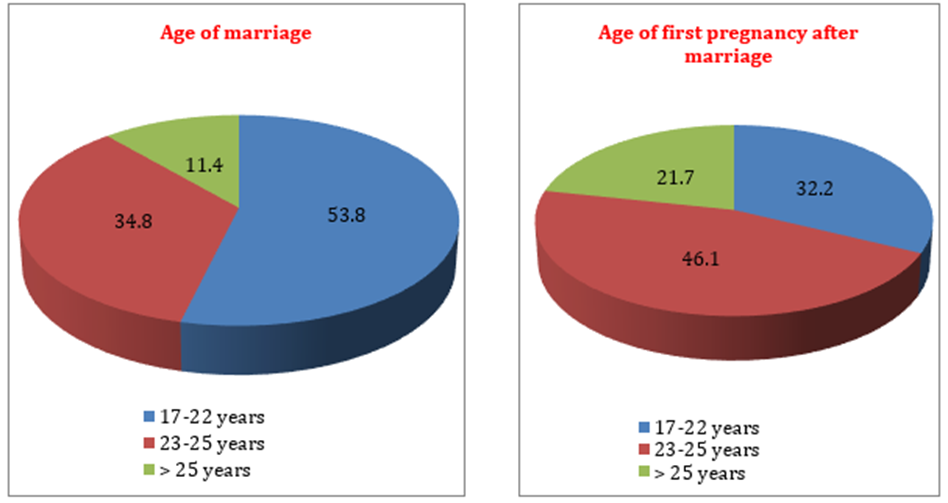
Figure 1: Age of marriage foe the studied female workers Figure 2: Age of the first pregnancy after marriage for the
studied female workers
Figure 1 & 2: reveals that more than half (53.8%) of them were married at ages 17-22 years, and less than half (46.1%) of them had their first pregnancy at ages 23-25 years.
Figure (3) showed that the majority (82.8%) of them had practiced breastfeeding, while non-breastfeeding women due to rejection of the child were less than three quarters (73.9%).
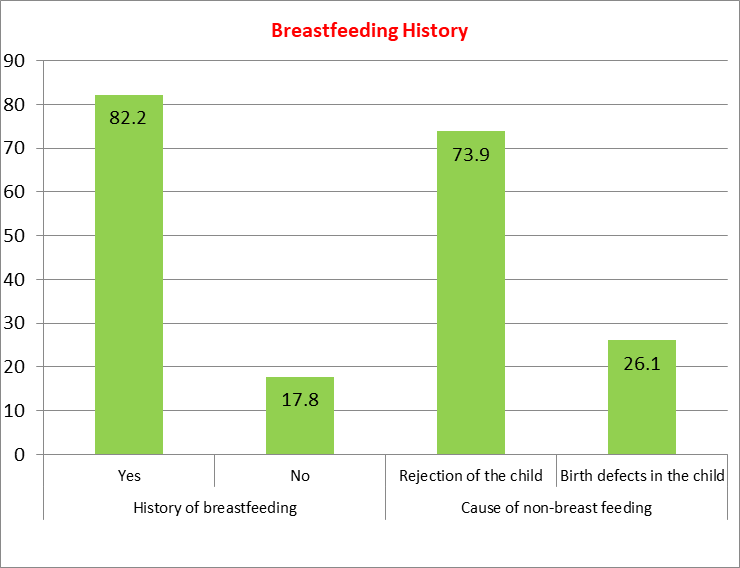
Figure 3: Breastfeeding History of the studied female workers.
Figure (4) revealed that most of the studied women (83.9%) had not had their menstrual cycle stopped, and less than two-thirds (65.4%) had it stopped at age >45 years.
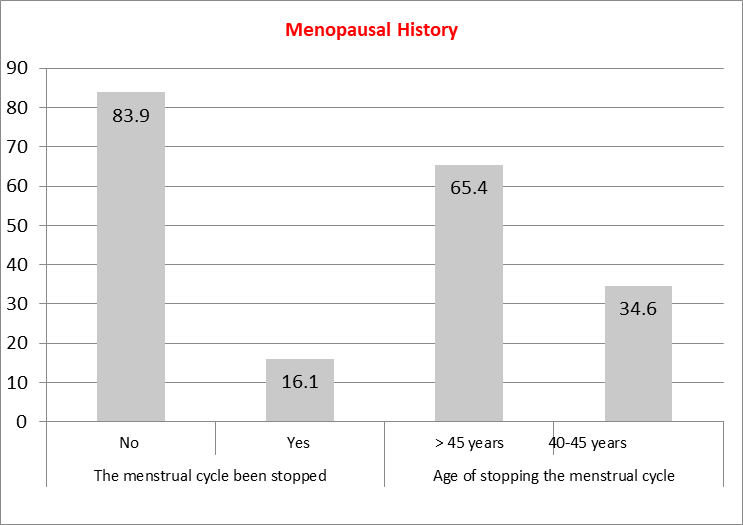
Figure 4: Menopausal History of the studied female workers.
Figure (5) revealed that less than three-quarters (71.8%) of them had used contraception from them; less than two-thirds (63.8%) had used vaginal IUDs, and less than two-thirds (61.6%) of them used contraception for more than 2 years. Regarding the complication of contraception, almost three-quarters (75.0%) of them had no complications, while women who had complications due to bleeding were more than half (58.6%).
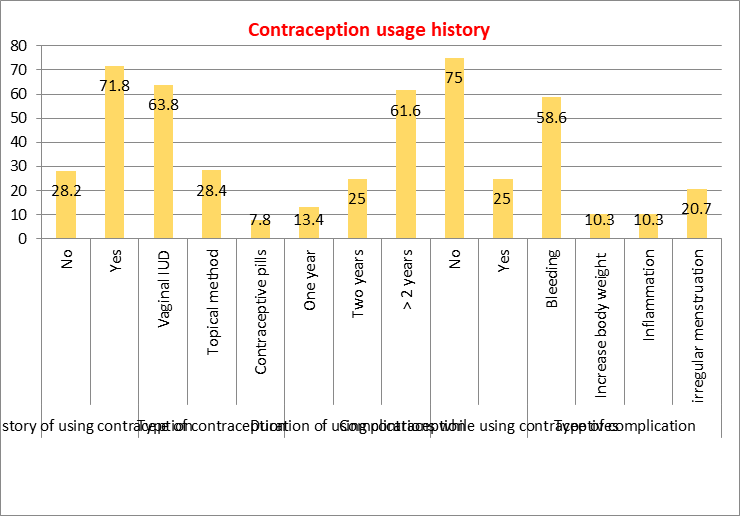
Figure 5: Contraception usage History of the studied female workers.
Figure (6) presents that, less than three quarter (73.1%) of the studied female workers didn’t have family history of breast cancer while female who had family history of breast cancer with first degree relatives (mother) were less than half (40.0%). Additionally, majority (93.5%) of them didn’t performed mammogram. Meanwhile, less than three quarter (70.0%) of them didn’t have breast problems while less than one third (33.0%) of them had problem due to discharge. Despite that, more than half (59.8%) of female who had breast problem hadn’t done any special investigation for this problem and less than two thirds (64.1%) of female who perform investigations had done medical breast examination.
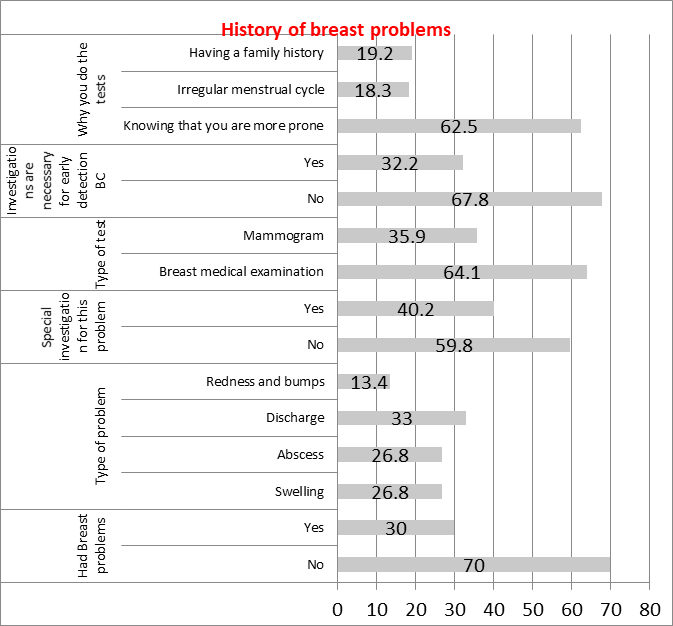
Figure 6: History of breast problems of the studied female workers.
Table (7) Related to BSE, more than half (50.5%) of them knew that breast self-examination was the first method in the early diagnosis of breast cancer. In addition, nearly three-quarters (74.9%) of them did not practice breast self-examination, with less than half (48.3%) not knowing how it was practiced.
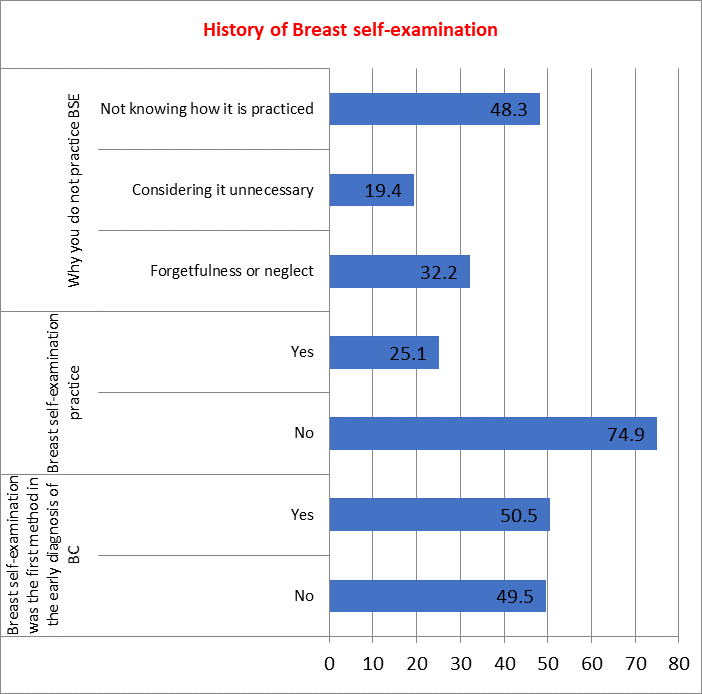
Figure 7: History of Breast self-examination of the studied female workers.
Figure (8) presents that 73.1% of the studied female workers didn’t have a family history of breast cancer, while females who had a family history of breast cancer with first-degree relatives (mothers) were 40.0%.
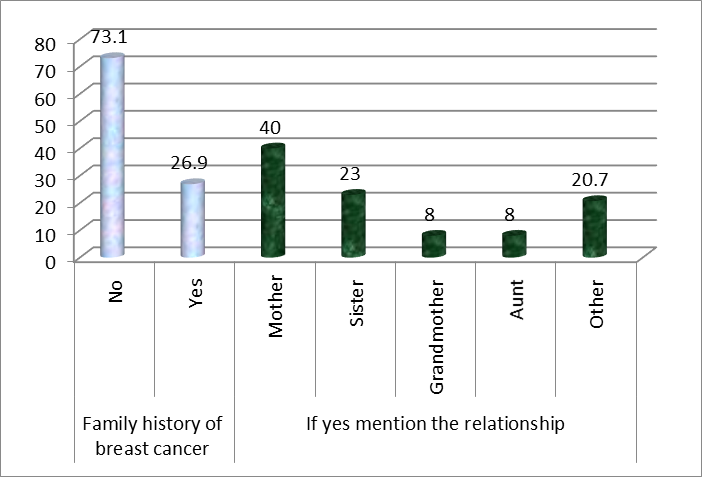
Figure 8: Percentage distribution of the studied female workers regarding their family history of breast cancer (n=323).
Figure (9) shows most of the studied sample have inadequate level regarding their Sub-items of breast self-examination practices (examination preparation 76.2%, examination by consideration 88.2%, asymmetry in the nipple, areola, or breast90.4%, and tactile examination 91.6%) compared to adequate level (23.8%, 11.8%. 9.6%, 8.4), respectively.
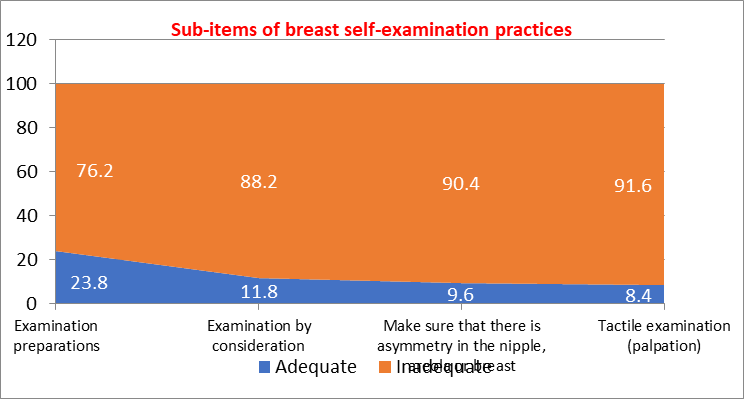
Figure 9: Percentage distribution of the studied female workers regarding their Sub-items of breast self-examination practices (n=323).
Figure (10) illustrates that female workers’ total practice level regarding breast self-examination, less than one-tenth (9.9%) of the female workers having adequate practice compared to 90.1% inadequate.
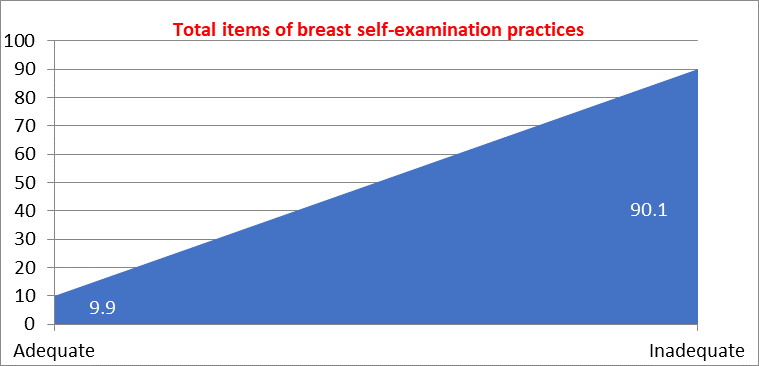
Figure 10: Percentage distribution of the studied female workers regarding their Total-items of breast self-examination practices (n=323).
Figure (11) presents the source of information about breast cancer, less than half (44.9%) of them get information from social media.
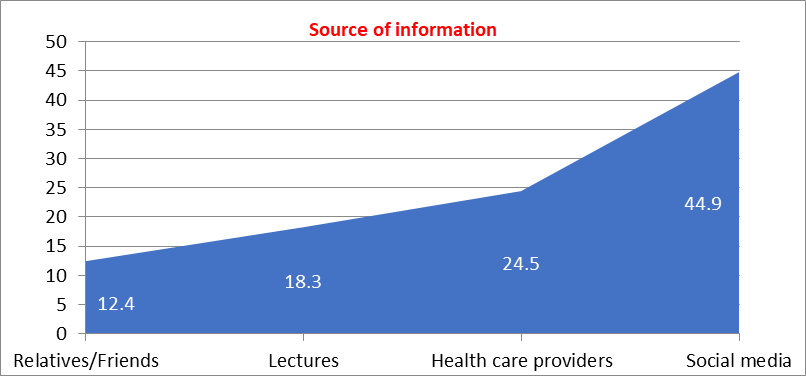
Figure 11: studied female workers regarding their source of information about breast cancer.
Table (1) and Figure (12) reveals that there was a highly statistically significant relation between the studied female workers total practices level regarding breast self-examination score with their educational level and place of residence, as P-value = 0.000 & 0.001, respectively.
| Items | No. | Inadequate (n=291) | Adequate (n=32) | X2 p value |
| % | % | |||
| Age | ||||
| 20 > 30 yrs. | 89 | 25.7 | 1.9 | 9.003 (0.011*) |
| 30 > 40 yrs. | 164 | 43.4 | 7.4 | |
| ≥40 yrs. | 70 | 21.0 | 0.6 | |
| Educational level | ||||
| Intermediate education | 97 | 28.5 | 1.5 | 28.533 (0.000**) |
| University education | 148 | 43.7 | 2.2 | |
| Above university | 78 | 17.9 | 6.2 | |
| Marital status | ||||
| Single | 53 | 16.0 | 0.3 | 6.297 (0.043*) |
| Married | 245 | 66.6 | 9.3 | |
| Divorced | 25 | 7.5 | 0.3 | |
| Place of residence | ||||
| Rural area | 100 | 30.4 | 0.6 | 10.146 (0.001**) |
| Urban area | 223 | 59.7 | 9.3 | |
| Monthly income of family | ||||
| Enough and increases | 13 | 4.0 | 0.0 | 4.360 (0.113) |
| Enough | 272 | 74.6 | 9.6 | |
| Not enough | 38 | 11.5 | 0.3 |
| Not enough | 38 | 11.5 | 0.3 |
Table 1: Relation between socio-demographic characteristics of the studied female workers and their total practices level regarding breast self-examination (n=323).
* Statistically significant at p≤0.05 ** Highly statistical significant at p≤0.01
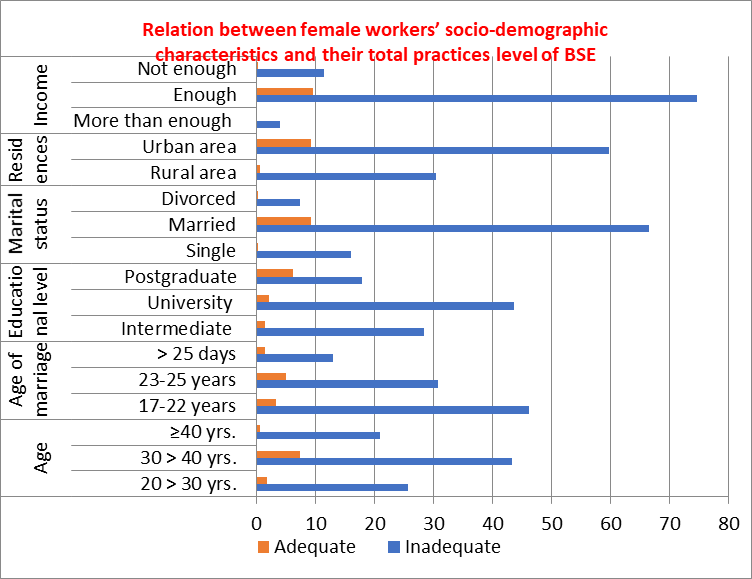
Figure 12: Relation between socio-demographic characteristics of the studied female workers and their total practices level of breast self-examination.
Figure (13) illustrates a statistically significant relation between family history of breast cancer and their total practices level of breast self-examination as P-value = 0.018
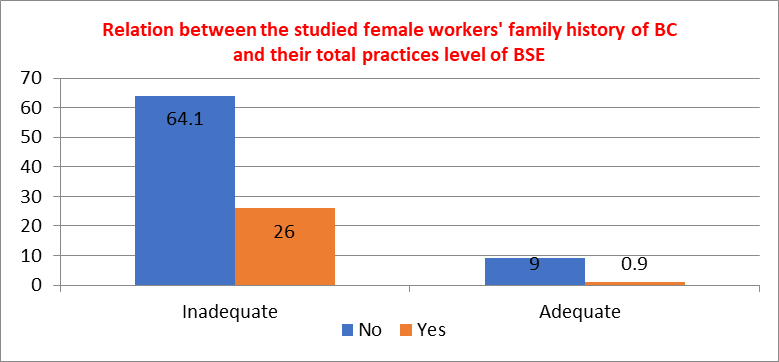
Figure 13: Relation between the studied female workers' family history of breast cancer and their total practices level of breast self-examination (p= 0.018*).
Figure (14) illustrates that there was no statistically significant relation between of the studied female workers and their total practices level regarding breast self-examination as p= 0.414.
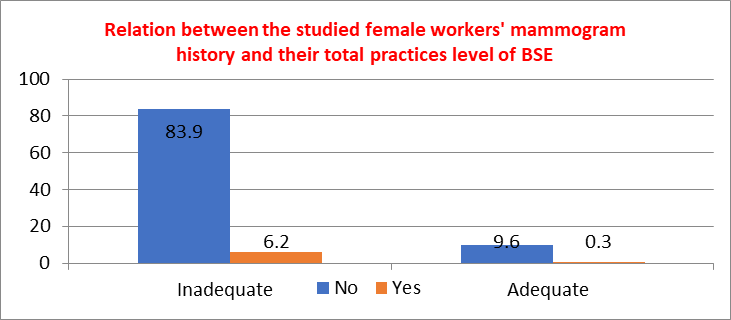
Figure 14: Relation between the studied female workers' mammogram history and their total practices level of breast self-examination (p= 0.269).
Figure (15) illustrates that there was no statistically significant relation between history of breast problems of the studied female workers and their total practices level regarding breast self-examination as P= 0.513
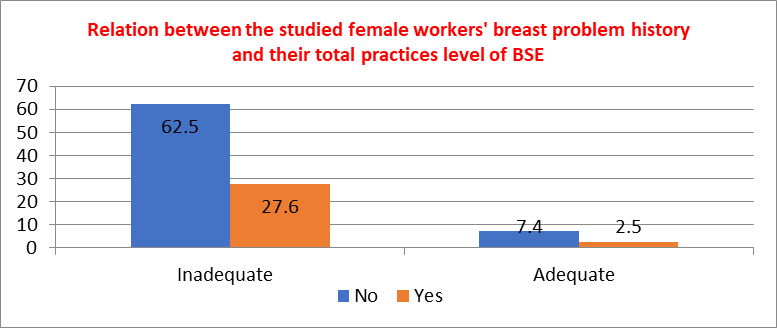
Figure 15: Relation between the studied female workers' breast problem history and their total practices level of breast self-examination (p= 0.339).
Figure (16) illustrates that there the source of information about breast cancer, there is a highly statistically significant relation with their total practice level of breast self-examination as P-value = 0.000.
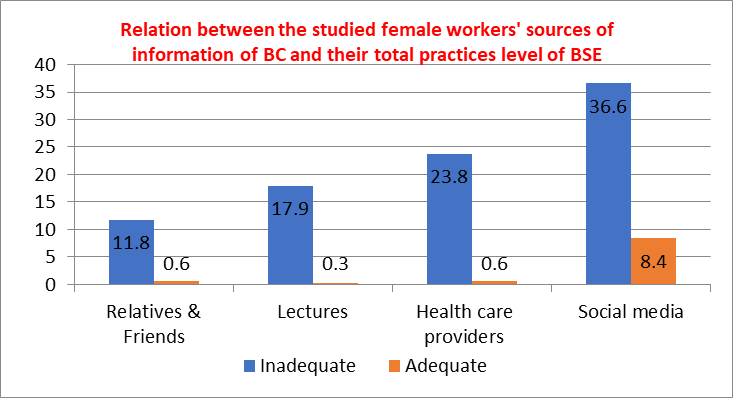
Figure 16: Relation between the studied female workers' sources of information of breast cancer and their total practices level of breast self-examination (p=0.000**).
Self-examination of breasts helps women identify changes and identify breast cancers early, especially after menstruation, as many breast cancers are discovered by women themselves [12-17]. The aim of the study was assess female workers’ total practices regarding breast self-examination at Beni-Suef University. Regarding items for practice of breast self-examination (BSE) the current study announced that most of participated women had inadequate practices of breast self-examination regarding all sub-item (Examination preparations, Examination by consideration, Make sure that there is an asymmetry in the nipple, areola, or breast, and Tactile examination or palpation). The finding was in the same line with Akarsu & Andsoy (2022) [18]. Concerning total BSE practices, it noticed that majority of females had inadequate practice regarding BSE. This finding was in the same line with Alameer et al. (2018) [19]. Regarding the source of information about breast cancer, the current study illustrated that less than half of female workers get information from social media. This finding disagrees with Hajian and Auladi (2015), who studied “awareness, attitude, and practice of breast cancer screening women, and the associated socio-demographic characteristics, in northern Iran” and reported that the source of information was health care workers, and magazines, books, and brochures were the most common sources [20]. From the researcher's point of view, this finding might be due to a lack of breast cancer mass programs, and the majority of studied women did not have a family history of breast cancer. The study found a significant relationship between socio-demographic characteristics and breast self-examination practices among female workers, with age pretest showing a significant association, while no significant relationship was found for the minority aged 30-40 years, similar to Mahmoud et al.'s 2020 findings [21]. Moreover, the study found a significant relationship between female workers' breast self-examination practices and their educational level, with university-educated females having adequate practice. This supports Ahmed and Shrief's (2019) findings, suggesting that education improves understanding and application of BSE steps [22]. Additionally, the study found no significant relationship between female workers' breast self-examination practices and their family income. However, a minority of females with sufficient monthly income had adequate practice, contradicting previous research suggesting a link between income and BSE practice Dündar et al. (2006) and Marinho et al. (2008) [23-24]. Also, there was a statistically significant relationship between the studied female workers total practices level of breast self-examination score with their marital status level. In which less than one-tenth of married women had adequate practice regarding breast self-examination. This finding is also in the same line with Montazeri et al. (2008), who clarified that performing BSE was significantly related to age, marital status, and educational level. Regarding place of residence, there was a highly statistically significant relationship between the studied female workers total practices level of breast self-examination score and their place of residence [25]. In which the minority of females who lived in urban areas had adequate practice regarding breast self-examination. This finding is similar to Mahmoud et al. (2020), who showed that there is a statistically significant association between women's total practice scores and residence. From the researcher's point of view, females who live in urban areas have the ability to receive information and practice BSE, even if it causes embarrassment. Unlike women who live in rural areas [21]. For the relationship between the family history of breast cancer of the studied women and their total practice level of breast self-examination, the results revealed a statistically significant relationship. In which the minority of females who didn’t have a family history of breast cancer had adequate practice regarding breast self-examination. Also, this finding is supported by Meilina et al. (2024), who investigated “the relationship of knowledge, attitudes, and family history of breast cancer to breast self-examination (BSE) behavior in women” and revealed that there was no relationship between family breast cancer history and BSE [26]. Concerning the relation between the studied female workers' mammogram history and breast problem history and their total practice level of breast self-examination, the results revealed that no statistically significant relationship was found for both. However, the majority of females who have neither breast problem nor mammogram history had inadequate practice regarding breast self-examination As regard the source of information about breast cancer, there was a highly statistically significant relationship with their total practice level of breast self-examination. In which the minority of females who get their information from social media have adequate practice regarding breast self-examination. This finding is similar to Parsa et al. (2008), who assessed “knowledge and behavior regarding breast cancer screening among female teachers in Selangor, Malaysia” and revealed that there was no significant association between the sources of information and breast cancer screening practices [27].
Based on the findings of the present study, it can be concluded that there were statistically significant relation between the studied female workers total practices level regarding breast self-examination score with their educational level and place of residence, family history of breast cancer. A highly statistically significant relation with their total practice level of breast self-examination and source of information was observed.
Clearly Auctoresonline and particularly Psychology and Mental Health Care Journal is dedicated to improving health care services for individuals and populations. The editorial boards' ability to efficiently recognize and share the global importance of health literacy with a variety of stakeholders. Auctoresonline publishing platform can be used to facilitate of optimal client-based services and should be added to health care professionals' repertoire of evidence-based health care resources.

Journal of Clinical Cardiology and Cardiovascular Intervention The submission and review process was adequate. However I think that the publication total value should have been enlightened in early fases. Thank you for all.

Journal of Women Health Care and Issues By the present mail, I want to say thank to you and tour colleagues for facilitating my published article. Specially thank you for the peer review process, support from the editorial office. I appreciate positively the quality of your journal.
Journal of Clinical Research and Reports I would be very delighted to submit my testimonial regarding the reviewer board and the editorial office. The reviewer board were accurate and helpful regarding any modifications for my manuscript. And the editorial office were very helpful and supportive in contacting and monitoring with any update and offering help. It was my pleasure to contribute with your promising Journal and I am looking forward for more collaboration.

We would like to thank the Journal of Thoracic Disease and Cardiothoracic Surgery because of the services they provided us for our articles. The peer-review process was done in a very excellent time manner, and the opinions of the reviewers helped us to improve our manuscript further. The editorial office had an outstanding correspondence with us and guided us in many ways. During a hard time of the pandemic that is affecting every one of us tremendously, the editorial office helped us make everything easier for publishing scientific work. Hope for a more scientific relationship with your Journal.

The peer-review process which consisted high quality queries on the paper. I did answer six reviewers’ questions and comments before the paper was accepted. The support from the editorial office is excellent.

Journal of Neuroscience and Neurological Surgery. I had the experience of publishing a research article recently. The whole process was simple from submission to publication. The reviewers made specific and valuable recommendations and corrections that improved the quality of my publication. I strongly recommend this Journal.

Dr. Katarzyna Byczkowska My testimonial covering: "The peer review process is quick and effective. The support from the editorial office is very professional and friendly. Quality of the Clinical Cardiology and Cardiovascular Interventions is scientific and publishes ground-breaking research on cardiology that is useful for other professionals in the field.

Thank you most sincerely, with regard to the support you have given in relation to the reviewing process and the processing of my article entitled "Large Cell Neuroendocrine Carcinoma of The Prostate Gland: A Review and Update" for publication in your esteemed Journal, Journal of Cancer Research and Cellular Therapeutics". The editorial team has been very supportive.

Testimony of Journal of Clinical Otorhinolaryngology: work with your Reviews has been a educational and constructive experience. The editorial office were very helpful and supportive. It was a pleasure to contribute to your Journal.

Dr. Bernard Terkimbi Utoo, I am happy to publish my scientific work in Journal of Women Health Care and Issues (JWHCI). The manuscript submission was seamless and peer review process was top notch. I was amazed that 4 reviewers worked on the manuscript which made it a highly technical, standard and excellent quality paper. I appreciate the format and consideration for the APC as well as the speed of publication. It is my pleasure to continue with this scientific relationship with the esteem JWHCI.

This is an acknowledgment for peer reviewers, editorial board of Journal of Clinical Research and Reports. They show a lot of consideration for us as publishers for our research article “Evaluation of the different factors associated with side effects of COVID-19 vaccination on medical students, Mutah university, Al-Karak, Jordan”, in a very professional and easy way. This journal is one of outstanding medical journal.
Dear Hao Jiang, to Journal of Nutrition and Food Processing We greatly appreciate the efficient, professional and rapid processing of our paper by your team. If there is anything else we should do, please do not hesitate to let us know. On behalf of my co-authors, we would like to express our great appreciation to editor and reviewers.

As an author who has recently published in the journal "Brain and Neurological Disorders". I am delighted to provide a testimonial on the peer review process, editorial office support, and the overall quality of the journal. The peer review process at Brain and Neurological Disorders is rigorous and meticulous, ensuring that only high-quality, evidence-based research is published. The reviewers are experts in their fields, and their comments and suggestions were constructive and helped improve the quality of my manuscript. The review process was timely and efficient, with clear communication from the editorial office at each stage. The support from the editorial office was exceptional throughout the entire process. The editorial staff was responsive, professional, and always willing to help. They provided valuable guidance on formatting, structure, and ethical considerations, making the submission process seamless. Moreover, they kept me informed about the status of my manuscript and provided timely updates, which made the process less stressful. The journal Brain and Neurological Disorders is of the highest quality, with a strong focus on publishing cutting-edge research in the field of neurology. The articles published in this journal are well-researched, rigorously peer-reviewed, and written by experts in the field. The journal maintains high standards, ensuring that readers are provided with the most up-to-date and reliable information on brain and neurological disorders. In conclusion, I had a wonderful experience publishing in Brain and Neurological Disorders. The peer review process was thorough, the editorial office provided exceptional support, and the journal's quality is second to none. I would highly recommend this journal to any researcher working in the field of neurology and brain disorders.

Dear Agrippa Hilda, Journal of Neuroscience and Neurological Surgery, Editorial Coordinator, I trust this message finds you well. I want to extend my appreciation for considering my article for publication in your esteemed journal. I am pleased to provide a testimonial regarding the peer review process and the support received from your editorial office. The peer review process for my paper was carried out in a highly professional and thorough manner. The feedback and comments provided by the authors were constructive and very useful in improving the quality of the manuscript. This rigorous assessment process undoubtedly contributes to the high standards maintained by your journal.

International Journal of Clinical Case Reports and Reviews. I strongly recommend to consider submitting your work to this high-quality journal. The support and availability of the Editorial staff is outstanding and the review process was both efficient and rigorous.

Thank you very much for publishing my Research Article titled “Comparing Treatment Outcome Of Allergic Rhinitis Patients After Using Fluticasone Nasal Spray And Nasal Douching" in the Journal of Clinical Otorhinolaryngology. As Medical Professionals we are immensely benefited from study of various informative Articles and Papers published in this high quality Journal. I look forward to enriching my knowledge by regular study of the Journal and contribute my future work in the field of ENT through the Journal for use by the medical fraternity. The support from the Editorial office was excellent and very prompt. I also welcome the comments received from the readers of my Research Article.

Dear Erica Kelsey, Editorial Coordinator of Cancer Research and Cellular Therapeutics Our team is very satisfied with the processing of our paper by your journal. That was fast, efficient, rigorous, but without unnecessary complications. We appreciated the very short time between the submission of the paper and its publication on line on your site.

I am very glad to say that the peer review process is very successful and fast and support from the Editorial Office. Therefore, I would like to continue our scientific relationship for a long time. And I especially thank you for your kindly attention towards my article. Have a good day!

"We recently published an article entitled “Influence of beta-Cyclodextrins upon the Degradation of Carbofuran Derivatives under Alkaline Conditions" in the Journal of “Pesticides and Biofertilizers” to show that the cyclodextrins protect the carbamates increasing their half-life time in the presence of basic conditions This will be very helpful to understand carbofuran behaviour in the analytical, agro-environmental and food areas. We greatly appreciated the interaction with the editor and the editorial team; we were particularly well accompanied during the course of the revision process, since all various steps towards publication were short and without delay".

I would like to express my gratitude towards you process of article review and submission. I found this to be very fair and expedient. Your follow up has been excellent. I have many publications in national and international journal and your process has been one of the best so far. Keep up the great work.

We are grateful for this opportunity to provide a glowing recommendation to the Journal of Psychiatry and Psychotherapy. We found that the editorial team were very supportive, helpful, kept us abreast of timelines and over all very professional in nature. The peer review process was rigorous, efficient and constructive that really enhanced our article submission. The experience with this journal remains one of our best ever and we look forward to providing future submissions in the near future.

I am very pleased to serve as EBM of the journal, I hope many years of my experience in stem cells can help the journal from one way or another. As we know, stem cells hold great potential for regenerative medicine, which are mostly used to promote the repair response of diseased, dysfunctional or injured tissue using stem cells or their derivatives. I think Stem Cell Research and Therapeutics International is a great platform to publish and share the understanding towards the biology and translational or clinical application of stem cells.

I would like to give my testimony in the support I have got by the peer review process and to support the editorial office where they were of asset to support young author like me to be encouraged to publish their work in your respected journal and globalize and share knowledge across the globe. I really give my great gratitude to your journal and the peer review including the editorial office.

I am delighted to publish our manuscript entitled "A Perspective on Cocaine Induced Stroke - Its Mechanisms and Management" in the Journal of Neuroscience and Neurological Surgery. The peer review process, support from the editorial office, and quality of the journal are excellent. The manuscripts published are of high quality and of excellent scientific value. I recommend this journal very much to colleagues.

Dr.Tania Muñoz, My experience as researcher and author of a review article in The Journal Clinical Cardiology and Interventions has been very enriching and stimulating. The editorial team is excellent, performs its work with absolute responsibility and delivery. They are proactive, dynamic and receptive to all proposals. Supporting at all times the vast universe of authors who choose them as an option for publication. The team of review specialists, members of the editorial board, are brilliant professionals, with remarkable performance in medical research and scientific methodology. Together they form a frontline team that consolidates the JCCI as a magnificent option for the publication and review of high-level medical articles and broad collective interest. I am honored to be able to share my review article and open to receive all your comments.

“The peer review process of JPMHC is quick and effective. Authors are benefited by good and professional reviewers with huge experience in the field of psychology and mental health. The support from the editorial office is very professional. People to contact to are friendly and happy to help and assist any query authors might have. Quality of the Journal is scientific and publishes ground-breaking research on mental health that is useful for other professionals in the field”.

Dear editorial department: On behalf of our team, I hereby certify the reliability and superiority of the International Journal of Clinical Case Reports and Reviews in the peer review process, editorial support, and journal quality. Firstly, the peer review process of the International Journal of Clinical Case Reports and Reviews is rigorous, fair, transparent, fast, and of high quality. The editorial department invites experts from relevant fields as anonymous reviewers to review all submitted manuscripts. These experts have rich academic backgrounds and experience, and can accurately evaluate the academic quality, originality, and suitability of manuscripts. The editorial department is committed to ensuring the rigor of the peer review process, while also making every effort to ensure a fast review cycle to meet the needs of authors and the academic community. Secondly, the editorial team of the International Journal of Clinical Case Reports and Reviews is composed of a group of senior scholars and professionals with rich experience and professional knowledge in related fields. The editorial department is committed to assisting authors in improving their manuscripts, ensuring their academic accuracy, clarity, and completeness. Editors actively collaborate with authors, providing useful suggestions and feedback to promote the improvement and development of the manuscript. We believe that the support of the editorial department is one of the key factors in ensuring the quality of the journal. Finally, the International Journal of Clinical Case Reports and Reviews is renowned for its high- quality articles and strict academic standards. The editorial department is committed to publishing innovative and academically valuable research results to promote the development and progress of related fields. The International Journal of Clinical Case Reports and Reviews is reasonably priced and ensures excellent service and quality ratio, allowing authors to obtain high-level academic publishing opportunities in an affordable manner. I hereby solemnly declare that the International Journal of Clinical Case Reports and Reviews has a high level of credibility and superiority in terms of peer review process, editorial support, reasonable fees, and journal quality. Sincerely, Rui Tao.

Clinical Cardiology and Cardiovascular Interventions I testity the covering of the peer review process, support from the editorial office, and quality of the journal.

Clinical Cardiology and Cardiovascular Interventions, we deeply appreciate the interest shown in our work and its publication. It has been a true pleasure to collaborate with you. The peer review process, as well as the support provided by the editorial office, have been exceptional, and the quality of the journal is very high, which was a determining factor in our decision to publish with you.
The peer reviewers process is quick and effective, the supports from editorial office is excellent, the quality of journal is high. I would like to collabroate with Internatioanl journal of Clinical Case Reports and Reviews journal clinically in the future time.

Clinical Cardiology and Cardiovascular Interventions, I would like to express my sincerest gratitude for the trust placed in our team for the publication in your journal. It has been a true pleasure to collaborate with you on this project. I am pleased to inform you that both the peer review process and the attention from the editorial coordination have been excellent. Your team has worked with dedication and professionalism to ensure that your publication meets the highest standards of quality. We are confident that this collaboration will result in mutual success, and we are eager to see the fruits of this shared effort.

Dear Dr. Jessica Magne, Editorial Coordinator 0f Clinical Cardiology and Cardiovascular Interventions, I hope this message finds you well. I want to express my utmost gratitude for your excellent work and for the dedication and speed in the publication process of my article titled "Navigating Innovation: Qualitative Insights on Using Technology for Health Education in Acute Coronary Syndrome Patients." I am very satisfied with the peer review process, the support from the editorial office, and the quality of the journal. I hope we can maintain our scientific relationship in the long term.
Dear Monica Gissare, - Editorial Coordinator of Nutrition and Food Processing. ¨My testimony with you is truly professional, with a positive response regarding the follow-up of the article and its review, you took into account my qualities and the importance of the topic¨.

Dear Dr. Jessica Magne, Editorial Coordinator 0f Clinical Cardiology and Cardiovascular Interventions, The review process for the article “The Handling of Anti-aggregants and Anticoagulants in the Oncologic Heart Patient Submitted to Surgery” was extremely rigorous and detailed. From the initial submission to the final acceptance, the editorial team at the “Journal of Clinical Cardiology and Cardiovascular Interventions” demonstrated a high level of professionalism and dedication. The reviewers provided constructive and detailed feedback, which was essential for improving the quality of our work. Communication was always clear and efficient, ensuring that all our questions were promptly addressed. The quality of the “Journal of Clinical Cardiology and Cardiovascular Interventions” is undeniable. It is a peer-reviewed, open-access publication dedicated exclusively to disseminating high-quality research in the field of clinical cardiology and cardiovascular interventions. The journal's impact factor is currently under evaluation, and it is indexed in reputable databases, which further reinforces its credibility and relevance in the scientific field. I highly recommend this journal to researchers looking for a reputable platform to publish their studies.

Dear Editorial Coordinator of the Journal of Nutrition and Food Processing! "I would like to thank the Journal of Nutrition and Food Processing for including and publishing my article. The peer review process was very quick, movement and precise. The Editorial Board has done an extremely conscientious job with much help, valuable comments and advices. I find the journal very valuable from a professional point of view, thank you very much for allowing me to be part of it and I would like to participate in the future!”

Dealing with The Journal of Neurology and Neurological Surgery was very smooth and comprehensive. The office staff took time to address my needs and the response from editors and the office was prompt and fair. I certainly hope to publish with this journal again.Their professionalism is apparent and more than satisfactory. Susan Weiner

My Testimonial Covering as fellowing: Lin-Show Chin. The peer reviewers process is quick and effective, the supports from editorial office is excellent, the quality of journal is high. I would like to collabroate with Internatioanl journal of Clinical Case Reports and Reviews.

My experience publishing in Psychology and Mental Health Care was exceptional. The peer review process was rigorous and constructive, with reviewers providing valuable insights that helped enhance the quality of our work. The editorial team was highly supportive and responsive, making the submission process smooth and efficient. The journal's commitment to high standards and academic rigor makes it a respected platform for quality research. I am grateful for the opportunity to publish in such a reputable journal.
My experience publishing in International Journal of Clinical Case Reports and Reviews was exceptional. I Come forth to Provide a Testimonial Covering the Peer Review Process and the editorial office for the Professional and Impartial Evaluation of the Manuscript.

I would like to offer my testimony in the support. I have received through the peer review process and support the editorial office where they are to support young authors like me, encourage them to publish their work in your esteemed journals, and globalize and share knowledge globally. I really appreciate your journal, peer review, and editorial office.
Dear Agrippa Hilda- Editorial Coordinator of Journal of Neuroscience and Neurological Surgery, "The peer review process was very quick and of high quality, which can also be seen in the articles in the journal. The collaboration with the editorial office was very good."

I would like to express my sincere gratitude for the support and efficiency provided by the editorial office throughout the publication process of my article, “Delayed Vulvar Metastases from Rectal Carcinoma: A Case Report.” I greatly appreciate the assistance and guidance I received from your team, which made the entire process smooth and efficient. The peer review process was thorough and constructive, contributing to the overall quality of the final article. I am very grateful for the high level of professionalism and commitment shown by the editorial staff, and I look forward to maintaining a long-term collaboration with the International Journal of Clinical Case Reports and Reviews.
To Dear Erin Aust, I would like to express my heartfelt appreciation for the opportunity to have my work published in this esteemed journal. The entire publication process was smooth and well-organized, and I am extremely satisfied with the final result. The Editorial Team demonstrated the utmost professionalism, providing prompt and insightful feedback throughout the review process. Their clear communication and constructive suggestions were invaluable in enhancing my manuscript, and their meticulous attention to detail and dedication to quality are truly commendable. Additionally, the support from the Editorial Office was exceptional. From the initial submission to the final publication, I was guided through every step of the process with great care and professionalism. The team's responsiveness and assistance made the entire experience both easy and stress-free. I am also deeply impressed by the quality and reputation of the journal. It is an honor to have my research featured in such a respected publication, and I am confident that it will make a meaningful contribution to the field.

"I am grateful for the opportunity of contributing to [International Journal of Clinical Case Reports and Reviews] and for the rigorous review process that enhances the quality of research published in your esteemed journal. I sincerely appreciate the time and effort of your team who have dedicatedly helped me in improvising changes and modifying my manuscript. The insightful comments and constructive feedback provided have been invaluable in refining and strengthening my work".

I thank the ‘Journal of Clinical Research and Reports’ for accepting this article for publication. This is a rigorously peer reviewed journal which is on all major global scientific data bases. I note the review process was prompt, thorough and professionally critical. It gave us an insight into a number of important scientific/statistical issues. The review prompted us to review the relevant literature again and look at the limitations of the study. The peer reviewers were open, clear in the instructions and the editorial team was very prompt in their communication. This journal certainly publishes quality research articles. I would recommend the journal for any future publications.

Dear Jessica Magne, with gratitude for the joint work. Fast process of receiving and processing the submitted scientific materials in “Clinical Cardiology and Cardiovascular Interventions”. High level of competence of the editors with clear and correct recommendations and ideas for enriching the article.

We found the peer review process quick and positive in its input. The support from the editorial officer has been very agile, always with the intention of improving the article and taking into account our subsequent corrections.

My article, titled 'No Way Out of the Smartphone Epidemic Without Considering the Insights of Brain Research,' has been republished in the International Journal of Clinical Case Reports and Reviews. The review process was seamless and professional, with the editors being both friendly and supportive. I am deeply grateful for their efforts.
To Dear Erin Aust – Editorial Coordinator of Journal of General Medicine and Clinical Practice! I declare that I am absolutely satisfied with your work carried out with great competence in following the manuscript during the various stages from its receipt, during the revision process to the final acceptance for publication. Thank Prof. Elvira Farina

Dear Jessica, and the super professional team of the ‘Clinical Cardiology and Cardiovascular Interventions’ I am sincerely grateful to the coordinated work of the journal team for the no problem with the submission of my manuscript: “Cardiometabolic Disorders in A Pregnant Woman with Severe Preeclampsia on the Background of Morbid Obesity (Case Report).” The review process by 5 experts was fast, and the comments were professional, which made it more specific and academic, and the process of publication and presentation of the article was excellent. I recommend that my colleagues publish articles in this journal, and I am interested in further scientific cooperation. Sincerely and best wishes, Dr. Oleg Golyanovskiy.

Dear Ashley Rosa, Editorial Coordinator of the journal - Psychology and Mental Health Care. " The process of obtaining publication of my article in the Psychology and Mental Health Journal was positive in all areas. The peer review process resulted in a number of valuable comments, the editorial process was collaborative and timely, and the quality of this journal has been quickly noticed, resulting in alternative journals contacting me to publish with them." Warm regards, Susan Anne Smith, PhD. Australian Breastfeeding Association.

Dear Jessica Magne, Editorial Coordinator, Clinical Cardiology and Cardiovascular Interventions, Auctores Publishing LLC. I appreciate the journal (JCCI) editorial office support, the entire team leads were always ready to help, not only on technical front but also on thorough process. Also, I should thank dear reviewers’ attention to detail and creative approach to teach me and bring new insights by their comments. Surely, more discussions and introduction of other hemodynamic devices would provide better prevention and management of shock states. Your efforts and dedication in presenting educational materials in this journal are commendable. Best wishes from, Farahnaz Fallahian.
Dear Maria Emerson, Editorial Coordinator, International Journal of Clinical Case Reports and Reviews, Auctores Publishing LLC. I am delighted to have published our manuscript, "Acute Colonic Pseudo-Obstruction (ACPO): A rare but serious complication following caesarean section." I want to thank the editorial team, especially Maria Emerson, for their prompt review of the manuscript, quick responses to queries, and overall support. Yours sincerely Dr. Victor Olagundoye.

Dear Ashley Rosa, Editorial Coordinator, International Journal of Clinical Case Reports and Reviews. Many thanks for publishing this manuscript after I lost confidence the editors were most helpful, more than other journals Best wishes from, Susan Anne Smith, PhD. Australian Breastfeeding Association.

Dear Agrippa Hilda, Editorial Coordinator, Journal of Neuroscience and Neurological Surgery. The entire process including article submission, review, revision, and publication was extremely easy. The journal editor was prompt and helpful, and the reviewers contributed to the quality of the paper. Thank you so much! Eric Nussbaum, MD
Dr Hala Al Shaikh This is to acknowledge that the peer review process for the article ’ A Novel Gnrh1 Gene Mutation in Four Omani Male Siblings, Presentation and Management ’ sent to the International Journal of Clinical Case Reports and Reviews was quick and smooth. The editorial office was prompt with easy communication.

Dear Erin Aust, Editorial Coordinator, Journal of General Medicine and Clinical Practice. We are pleased to share our experience with the “Journal of General Medicine and Clinical Practice”, following the successful publication of our article. The peer review process was thorough and constructive, helping to improve the clarity and quality of the manuscript. We are especially thankful to Ms. Erin Aust, the Editorial Coordinator, for her prompt communication and continuous support throughout the process. Her professionalism ensured a smooth and efficient publication experience. The journal upholds high editorial standards, and we highly recommend it to fellow researchers seeking a credible platform for their work. Best wishes By, Dr. Rakhi Mishra.
